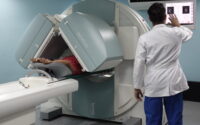Occupational Therapist Interview Questions
In this section find the direct download link for Occupational Therapist Interview Questions paper pdf. Download the Occupational Therapist Interview Questions papers pdf below and start your preparation. Hence, refer the Occupational Therapist Interview Questions Paper are part of the preparation. We are here to help you guys in finding the last 5 years Occupational Therapist Interview Questions Papers. The Occupational Therapist Interview Questions Papers are published here to help the Exam applicants.

Interview Questions for Occupational Therapist
1. Glasgow Coma scale ranges from –
(1) 0-15
(2) 1-15
(3) 3-15
(4) None of the above
2. Rehabilitation management of bum survivors can be divided into four overlapping phases, all of the following are correct, except –
(1) Phase I: Acute care phase lasting more than 1 week
(2) Phase IV: Reconstructive phase
(3) Phase III: Inpatient and outpatient rehabilitation phase
(4) Phase II: Surgical and postoperative phase
3. All of the following are Lymphedema treatment strategies, except –
(1) Surgical treatment
(2) Compression garments and lymphedema wrapping techniques
(3) Gentle exercise paired with diaphragmatic breathing
(4) Manual lymphatic drainage, pneumatic compression, and Complete Decongestive Therapy (CDT)
4. Autism spectrum disorder –
(1) Typically appears in 1st year of life
(2) Significantly affects person’s ability to communicate
(3) Frequently associated with usual behaviour
(4) All of the above
5. General fertility rate is –
(1) Live birth per one lakh reproductive age women per year
(2) Live birth per 1000 reproductive age women per year
(3) Live birth per 1000 reproductive age women
(4) Live birth per one lakh reproductive age women
6. Praxis is –
(1) Ability to conceive
(2) Ability to plan
(3) Ability to organise
(4) All of the above
7. Joint protection includes all, except –
(1) Use weakest joints available
(2) Avoid positions of deformity
(3) Use joints in their most stable anatomic & functional plane
(4) Respect pain
8. Bobath technique uses all, except –
(1) Kinesthetic senses
(2) Vestibular senses
(3) Tactile senses
(4) Proprioceptive senses
9. Which of the following are true regarding psychodynamic therapy?
(1) Focuses on the impact that life events have on the way we experience current events, protect ourselves from anxiety, and interact with others
(2) It uncovers factors that help explain why persons might engage in self-defeating beliaviour
(3) Emphasizes freedom, the option to choose, the courage to be, and the importance of meaning in life
(4) Both 1 and2
10. In Amyotrophic Lateral Sclerosis, all of the following are true, except –
(1) Phase I- patient is completely independent
(2) Phase III — patient is dependent
(3) Phase Il- patient is partially independent
(4) Phase IV — patient is partially dependent
11. Which of the following best defines the mid stance phase of the gait cycle?
(1) From flat foot position until the opposite foot is off the ground for swing
(2) From initial contact of the opposite foot and ends with ipsilateral toe-off meh
(3) From the time the opposite foot is lifted until the ipsilateral tibia is vertical
(4) None of these
12. Percentage of disability in stroke is calculated using –
(1) McGill Stroke Scale
(2) Modified Rankin Scale
(3) Modified Barthel Scale
(4) Disability Rating Scale
13. Which of the following are components of cognitive behavioral therapy in attention deficit hyperactivity disorder?
(1) Task analysis and anticipation of difficulties
(2) Exploration and selection of task specific strategies
(3) Application of the strategy of the task and its effectiveness
(4) Modeling, role-playing, and self-instruction
14. The centre of gravity of body is located –
(1) 5 cm in front of S1 vertebrae
(2) 5cm in front of lumbosacral junction
(3) 5 cm anterior to S2 vertebrae
(4) 5cm posterior to body of S2 vertebrae
15. Psyllium belongs to which category of drugs used for constipation?
(1) Osmotic purgatives
(2) Stimulant purgatives
(3) Stool softener
(4) Bulk forming
16. For a person with low back pain, what is the best advice that an Occupational therapist gives?
(1) Maintain a high chair
(2) Take breaks every 1 hour
(3) Maintain the hips and knees at 120 degree
(4) Change position every 30 minutes angle
17. After total shoulder replacement –
(1) Avoid shoulder internal rotation past 30°
(2) Avoid shoulder extension past 15°
(3) Avoid shoulder internal rotation past 15°
(4) Avoid shoulder extension past 30°
18. Psychological issues seen after burn injury –
(1) PTSD
(2) Adjustment disorder
(3) Depression
(4) All of the above
19. After injury, proliferation phase of wound healing starts on –
(1) 3 day
(2) 37 week
(3) 3rd month
(4) None of the above
20. Which of the following is true regarding Finkelstein test?
(1) It is done for de Quervain’s tenosynovitis
(2) It is done for Lateral epicondylitis
(3) It is done for scapholunate stability
(4) It is done for ligamentous laxity in hand
| Questions and Answers | Objective Question |
| Interview Question |
21. First carpo metacarpal joint is a type of which joint?
(1) Ball and socket joint
(2) Ellipsoid joint
(3) Saddle joint
(4) Pivot joint
22. United Nations General Assembly adopted its convention on the Rights of Persons with Disability on –
(1) 4th July, 1996
(2) 13th December, 2006
(3) 1st October, 2007
(4) 4th July, 1995
23. Live attenuated vaccine is –
(1) BCG
(2) HBV
(3) Rabies
(4) Influenza ae
24. Minimum percentage in “Rule of Nine” is given to
(1) Lower back
(2) Head
(3) Hand
(4) Genitals
25. Which of the following is the most commonly and specifically used measure to assess the clinical status in Multiple Sclerosis?
(1) Kellgren Lawrence scale
(2) FAM
(3) FIM
(4) Kurtzke’s Expanded Disability Status Scale
26. All of the following are indications of posterior leaf spring AFO, except –
(1) To treat stance phase second rocker deficiencies as they can control dynamic equinus in stance
(2) To maintain knee extensor couple
(3) Prevent drop foot in swing phase and ensure appropriate prepositioning of the foot for initial contact
(4) They facilitate the storage of energy
27. 1988 Revised American Rheumatism Association Criteria for Classification of Rheumatoid Arthritis diagnostic criteria, which of the following statement/s is correct?
(1) Morning stiffness in and around the joints lasting at least 30 mins before maximal improvement
(2) At least 3 joint areas simultaneously having soft tissue swelling or fluid (not bony overgrowth alone) observed by a physician (the 14 possible joint areas [right or left] PIP, MCP, wrist, elbow, knee ankle, and MTP joints)
(3) Both 1 and 2
(4) At least 2 joint areas swollen as above in wrist, MCP or PIP joint
28. What describes a Boutonniere deformity?
(1) Flexion of MCP, PIP and DIP joints
(2) Flexion of PIP joints with extension of DIP joints
(3) Extension of PIP joints with flexion of DIP joints
(4) Extension of MCP and PIP joints with flexion joints of DIP joints
29. What is Toe-touch-weight bearing technique, which is practiced after knee and hip replacement?
(1) No weight at all can be placed on the extremity involved
(2) Only the toe can be placed on the ground to provide some balance while standing – 90% of the weight is still on the unaffected leg
(3) Only 50% of the person’s body weight can be placed on the affected leg
(4) Clients are allowed to judge how much weight they are able to put on the affected leg without causing pain that may limit function
30. Which of the following is the primary outcome measure of OT services in Alzheimer’s disease?
(1) Katz Activities of Daily Living Scale
(2) Functional Behaviour Profile
(3) Instrumental Activities of Daily Living Scale
(4) The Activities of Daily Living Inventory
31. Sarcomere includes –
(1) I band + 2 (half of A band)
(2) Only A band
(3) Only I band
(4) A band +2 (half of I band)
32. What is the correct definition of light work?
(1) Exerting up to 20 lb of force occasionally, up to 10 lb of force frequently, or a negligible amount of force constantly to move objects toads
(2) Exerting up to 10 lbs of force occasionally
(3) Exerting 20 to 50 Ibs of force occasionally, 10-25 1b of force frequently, or greater than negligible and up to 10 lb of force constantly to move objects
(4) Exerting 50-100 ib of force occasionally, 25-50 Ib of force frequently or 10-20 Ib of force constantly to move objects
33. Which of the following types of cerebral palsy is most common?
(1) Flaccid
(2) Spastic
(3) Hemiparetic
(4) Dyskinetic
34. How much energy is required by a person to walk with crutches or braces?
(1) 6-7 MET
(2) 7-8 MET
(3) 3-4 MET
(4) 4-5 MET
35. Clinical presentation of Cauda Equina Syndrome are all, except –
(1) Increased tone of lower extremities
(2) Groin paresthesia
(3) Areflexic bowel and bladder
(4) Weakness of lower extremities
36. Pushing a table is an example of –
(1) Protective movement
(2) Non- Prehensile movement
(3) Prehensile movement
(4) Manipulative movement
37. Duchenne muscular dystrophy includes all, except –
(1) X linked recessive
(2) Autosomal recessive
(3) Defect in dystrophin gene
(4) Pseudohypertrophy
38. Which of the following is not a Gait determinant?
(1) Pelvic tilt
(2) Pelvic rotation
(3) Knee extension in stance phase
(4) Foot & knee mechanism
39. Bamboo spine is seen in –
(1) Rheumatoid Arthritis
(2) Reiter’s Syndrome
(3) Spinal Muscular atrophy
(4) Ankylosing Spondylitis
40. Occupational therapist evaluation in burn patient constitutes which of the following points?
(1) Preinjury body structure and function
(2) Past performance skills and patterns
(3) Preinjury personality traits and psychological status
(4) All of the above status
41. Maximum energy expenditure while using prosthesis occurs in –
(1) Unilateral Syme’s prosthesis
(2) Unilateral below knee prosthesis
(3) Unilateral above knee prosthesis
(4) Unilateral hip disarticulation prosthesis
42. Context is —
(a) The circumstances in which an event occurs, a setting
(b) The part of text or statement which surrounds a particular word or passage and determines it’s meaning without shaping or controlling influence
(1) a and b are false
(2) a and b are true
(3) a is false, b is true
(4) a is true, b is false
43. Cerebrospinal fluid is present in –
(1) Ventricles of brain
(2) Cisterns around the outside of brain Lalas
(3) Subarachnoid space
(4) All of the above
44. What is Occupational therapy practice framework?
(1) It defines occupational performance as resulting from the dynamic transaction among client, the context and the activity
(2) It defines interaction between person and the environment, affects human behaviour and performance, and that performance cannot be understood outside of context
(3) It defines the relationship between the person and the environment as an action oriented towards an object
(4) Both 1 and 2
45. What are the goals of a wheelchair seating system?
(1) Maximize functional independence with activities of daily living
(2) Minimize the risk of secondary injuries
(3) Correct or accommodate for skeletal deformities and ensure comfort
(4) All of the above
46. Which of the following best describes eccentric contractions?
(1) They are muscle shortening contractions
(2) They have high metabolic cost
(3) Slow eccentric contractions generate the least amount of force
(4) They cause more tissue damage than concentric contractions
47. Purposes of therapeutic exercises are all, except –
(1) To increase muscle power
(2) To maintain contractures
(3) To remediate ROM deficits
(4) To increase work tolerance
48. Which of the following classification system divides nerve injury into Neurapraxia, Axonotmesis, Neurotmesis?
(1) Seddon-Sunderland
(2) Seddon
(3) Lundborg
(4) Sunderland
49. What are the two important measurable landmarks of recovery from TBI?
(1) Post traumatic amnesia
(2) Emergence from vegetative state to minimally conscious state
(3) Eye opening
(4) Both 1 and2
50. Multiple sclerosis affects –
(1) Terminal branches
(2) Axon
(3) Myelin sheath
(4) Dendritic receptors pot
Occupational therapist job description
Occupational therapy is a rewarding and vital profession that focuses on assisting individuals of all ages to regain independence, enhance their quality of life, and engage in meaningful activities. Occupational therapists play a crucial role in evaluating, treating, and supporting individuals with various physical, mental, and developmental challenges. In this comprehensive article, we delve into the occupational therapist job description, exploring the core responsibilities, required skills, educational pathways, and the diverse settings in which these professionals make a significant impact.
Defining Occupational Therapy
To provide a solid foundation, this section outlines the core principles and objectives of occupational therapy. It explains the holistic approach adopted by occupational therapists, highlighting their dedication to promoting well-being and enabling individuals to participate in activities that are important to them.
Core Responsibilities of Occupational Therapists
This section details the key responsibilities and duties that occupational therapists undertake in their daily practice. It covers the following areas:
- Evaluation and Assessment: Occupational therapists conduct comprehensive evaluations and assessments to identify an individual’s strengths, challenges, and functional limitations.
- Treatment Planning: Based on evaluation findings, occupational therapists develop individualized treatment plans that address specific goals and promote optimal functioning.
- Therapeutic Interventions: Occupational therapists employ a wide range of therapeutic interventions, including activity modification, adaptive equipment training, and therapeutic exercises, to enhance clients’ independence and engagement in meaningful activities.
- Collaborative Approach: Occupational therapists work collaboratively with clients, families, and multidisciplinary teams to ensure comprehensive and coordinated care.
- Progress Monitoring and Documentation: Occupational therapists regularly monitor clients’ progress, adjust treatment plans as needed, and maintain accurate documentation of treatment sessions and outcomes.
Essential Skills and Competencies
Becoming a successful occupational therapist requires a diverse set of skills and competencies. This section highlights the essential skills needed to excel in the profession, including:
- Clinical Skills: Occupational therapists must possess a strong foundation in anatomy, physiology, and understanding of various conditions and disabilities.
- Assessment and Evaluation: Proficiency in conducting assessments, utilizing standardized tools, and analyzing assessment results are crucial for effective treatment planning.
- Therapeutic Techniques: Occupational therapists employ a wide array of therapeutic techniques and interventions tailored to individual needs.
- Communication and Interpersonal Skills: Strong communication skills enable occupational therapists to effectively collaborate with clients, families, and healthcare teams.
- Problem-Solving and Critical Thinking: Occupational therapists must think critically and creatively to develop innovative solutions for clients’ challenges.
- Empathy and Compassion: The ability to empathize and show compassion toward individuals facing difficulties is essential in building trust and rapport.
Educational Pathways and Licensing
To embark on a career as an occupational therapist, individuals must complete specific educational requirements and obtain appropriate licensure. This section discusses the educational pathways, including undergraduate and graduate programs, and the necessary certifications and licensing processes required to practice as an occupational therapist.
Occupational Therapy Settings
Occupational therapists work in diverse settings, tailoring their interventions to meet the unique needs of different populations. This section provides an overview of various practice settings, such as:
- Hospitals and Rehabilitation Centers
- Schools and Educational Institutions
- Community and Home Health Settings
- Mental Health Facilities
- Skilled Nursing Facilities
- Private Practice and Consultation
Specializations in Occupational Therapy
This section explores various specializations within the field of occupational therapy, allowing professionals to develop expertise in specific areas. Some common specializations include:
- Pediatrics: Occupational therapists specializing in pediatrics work with infants, children, and adolescents to address developmental delays, sensory processing disorders, and conditions such as autism spectrum disorder and cerebral palsy.
- Geriatrics: Occupational therapists specializing in geriatrics focus on the unique needs of older adults, including age-related conditions like arthritis, dementia, and stroke. They assist in promoting independence, fall prevention, and enhancing quality of life for older adults.
- Mental Health: Occupational therapists specializing in mental health provide support and treatment for individuals with mental health conditions, such as depression, anxiety, and schizophrenia. They help clients develop coping strategies, improve social skills, and engage in meaningful activities to enhance mental well-being.
- Hand Therapy: Hand therapists specialize in the rehabilitation of hand and upper extremity injuries, such as fractures, tendon injuries, and nerve conditions. They employ specialized techniques and interventions to restore hand function and facilitate a safe return to daily activities.
- Neurorehabilitation: Occupational therapists specializing in neurorehabilitation work with individuals who have experienced neurological conditions or injuries, such as stroke, traumatic brain injury, or spinal cord injury. They focus on improving motor skills, coordination, and functional independence.
- Work Rehabilitation: Occupational therapists specializing in work rehabilitation assist individuals in returning to work or maintaining employment. They assess job demands, provide ergonomic recommendations, and develop strategies to overcome barriers in the workplace.
Professional Development and Continuing Education
To stay current in the field and provide the highest quality of care, occupational therapists engage in professional development and lifelong learning. This section explores various avenues for continuing education, such as attending conferences, participating in workshops, pursuing advanced certifications, and engaging in research and evidence-based practice.
Job Outlook and Future Opportunities
The demand for occupational therapists is projected to grow significantly in the coming years. This section discusses the job outlook for occupational therapists, highlighting factors such as population demographics, increased recognition of occupational therapy’s benefits, and the expanding role of occupational therapists in addressing public health concerns.
Occupational therapy is a dynamic and impactful profession that empowers individuals to overcome challenges and live fulfilling lives. This comprehensive article has provided an in-depth exploration of the occupational therapist job description, encompassing core responsibilities, required skills, educational pathways, specialization opportunities, and the diverse settings in which occupational therapists practice. By understanding the multifaceted nature of the profession, aspiring occupational therapists can embark on a rewarding career path dedicated to promoting health, well-being, and meaningful engagement for individuals of all ages and abilities.



